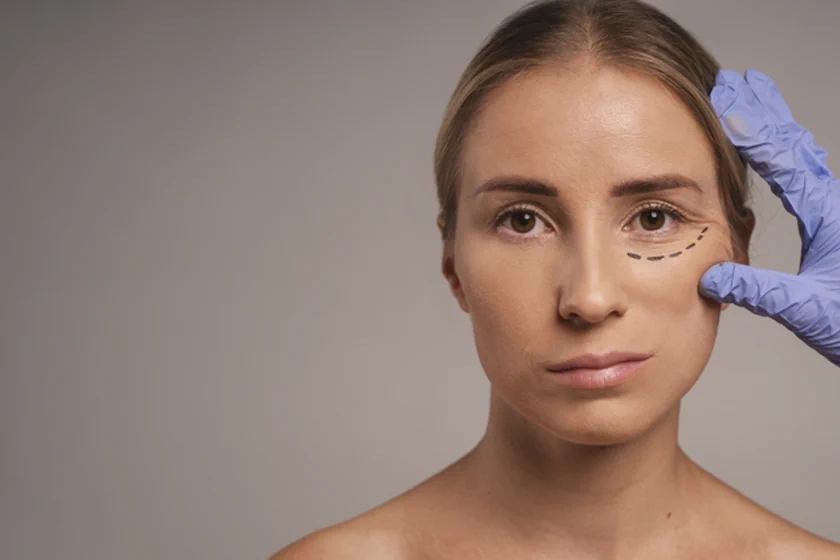|
Getting your Trinity Audio player ready...
|
In the domain of eye health, few challenges are as persistent and troubling as eyelid infections. Whether grappling with a troublesome stye or contending with an invasive fungal presence, finding effective treatment solutions is paramount. Thankfully, modern medicine offers an array of advanced techniques tailored to combat these issues.
Welcome to our guide, where we delve into practical and professional approaches to treating eyelid infections.
From trusted antibiotics to cutting-edge methodologies, we’ll navigate the landscape of infected eyelid treatment with clarity and simplicity.
What are Eyelid Infections?
Eyelid infections encompass a range of microbial afflictions affecting the delicate skin surrounding the eye. These conditions, such as styes, blepharitis, or fungal infections, often manifest as redness, swelling, and discomfort along the eyelid margins.
Styes, caused by bacterial infection of oil glands, typically appear as painful bumps, while blepharitis involves inflammation of the eyelid edges, often due to bacterial overgrowth or skin conditions.
Fungal infections, less common but equally disruptive, can lead to persistent irritation and require targeted treatment. Antibiotics are commonly prescribed for bacterial infections, while antifungal medications combat fungal invaders.
Proper eyelid hygiene, including regular cleansing and avoiding shared cosmetics, can aid in prevention. Prompt attention and appropriate treatment are essential to alleviate symptoms and prevent complications, ensuring optimal eye health and comfort.
Causes and Risk Factors of Eyelid Infections
Now that we have covered the basics, let us quickly understand the rooted causes of eyelid infections:
- Bacterial Overgrowth: Excessive proliferation of bacteria, particularly Staphylococcus aureus, can lead to infections such as styes and blepharitis.
- Blocked Oil Glands: Obstruction of the meibomian glands along the eyelid margin can result in the development of styes.
- Fungal Growth: Fungi like Candida or Aspergillus may thrive in warm, moist environments, leading to fungal eyelid infections.
- Poor Hygiene: Inadequate cleansing of the eyelids can contribute to the accumulation of bacteria and fungi, increasing infection risk.
- Contact Lenses: Improper handling or extended wear of contact lenses can introduce bacteria to the eye area, triggering infections.
- Compromised Immune System: Weakened immune defenses due to illness or medication can make individuals more susceptible to eyelid infections.
- Skin Conditions: Conditions like seborrheic dermatitis or eczema can disrupt the skin barrier, predisposing the eyelids to infection.
- Shared Cosmetics: Sharing makeup or eye care products can transfer bacteria and fungi, facilitating infection transmission.
Risk Factors of Eyelid Infections
- Poor eyelid hygiene, such as infrequent cleansing or improper makeup removal, can increase susceptibility to infections.
- Compromised immune system, due to factors like stress, illness, or medical treatments, can weaken the body’s ability to fend off infections.
- Contact lens wearers are at higher risk, as lenses can introduce bacteria or fungi to the eye area if not properly cleaned and stored.
- Skin conditions like acne rosacea or seborrheic dermatitis can predispose individuals to eyelid infections.
- Sharing makeup or personal items like towels can transfer bacteria or fungi, heightening the risk of infection transmission.
- Chronic conditions such as diabetes or autoimmune disorders may affect immune function and elevate the risk of eyelid infections.
- Environmental factors like air pollution or allergens can irritate the eyes and make them more susceptible to infection.
- Age can also be a factor, as older individuals may have reduced tear production or underlying health conditions that increase vulnerability to infections.
Symptoms to Watch For in Eyelid Infections
When it comes to eye health, vigilance is key. Recognizing the signs of eyelid infections early can make all the difference in swift and effective treatment. Here are the symptoms to keep a watchful eye on:
- Redness and swelling along the eyelid margins
- Pain or tenderness in the affected area
- Sensitivity to light (photophobia)
- Itching or irritation of the eyelid
- Formation of a bump or pustule on the eyelid (stye)
- Crusting or flaking of the eyelid skin
- Watery or mucous discharge from the eye
- Blurred vision or changes in vision clarity
- Feeling of grittiness or foreign body sensation in the eye
- Increased tearing or dryness of the eyes
Advanced Diagnostic Techniques for Eyelid Infections
Advanced diagnostic techniques play a pivotal role in accurately identifying and effectively treating eyelid infections. These methods, often employed by ophthalmologists or specialized eye care professionals, utilize cutting-edge technology to provide precise insights into the nature and extent of the infection.
Following cataract surgery, proper post-cataract surgery precautions and care are crucial for promoting healing, minimizing complications, and optimizing visual outcomes. Here are five essential tips to facilitate a smooth recovery process:
- Microbial Cultures: Culturing samples collected from the infected eyelid can pinpoint the specific bacteria or fungi responsible for the infection. This information enables healthcare providers to tailor treatment strategies accordingly, ensuring targeted and effective therapy.
- Swabbing and Smear Tests: Swabbing the affected area and examining the sample under a microscope can reveal the presence of microbial pathogens, aiding in diagnosis and guiding treatment decisions.
- In Vivo Confocal Microscopy: This non-invasive imaging technique allows for high-resolution visualization of the cornea and surrounding structures, facilitating the detection of subtle abnormalities associated with eyelid infections.
- Fluorescein Staining: By instilling a fluorescent dye into the eye, healthcare providers can assess the integrity of the ocular surface and identify areas of epithelial damage caused by the infection.
- Optical Coherence Tomography (OCT): OCT imaging provides detailed cross-sectional images of the eyelid and surrounding tissues, offering valuable insights into the extent of inflammation, tissue thickening, or structural changes associated with the infection.
Cutting-Edge Non-Surgical Treatments
In recent years, the landscape of eyelid infection treatment has expanded to include cutting-edge non-surgical interventions that offer effective alternatives to traditional approaches. These innovative treatments harness advanced technology and targeted therapies to address eyelid infections with precision and efficacy, sparing patients the need for invasive procedures.
Here are some of the groundbreaking non-surgical treatments revolutionizing the management of eyelid infections:
Laser Therapy: Utilizing focused laser energy, laser therapy can effectively target and eradicate bacteria or fungi responsible for eyelid infections. This non-invasive approach offers a quick and virtually painless solution for treating styes, blepharitis, and other infectious conditions, promoting rapid healing and symptom relief.
Photodynamic Therapy (PDT): PDT combines the use of photosensitizing agents and light therapy to selectively destroy microbial pathogens while preserving healthy tissues. By sensitizing bacteria or fungi to specific wavelengths of light, PDT offers a targeted and minimally invasive treatment option for eyelid infections, with minimal risk of side effects or complications.
Topical Antimicrobial Agents: Advancements in antimicrobial formulations have led to the development of potent topical agents specifically designed to combat eyelid infections. These innovative medications, available in various formulations such as ointments, gels, or solutions, deliver targeted therapy directly to the affected area, effectively eliminating microbial pathogens while minimizing systemic exposure and side effects.
Thermal Pulsation Therapy: Thermal pulsation therapy utilizes controlled heat and massage to unclog and stimulate the meibomian glands, which play a crucial role in maintaining the health of the eyelids and preventing infections. By restoring proper gland function and promoting the release of healthy oils, thermal pulsation therapy offers a non-surgical approach to managing conditions like blepharitis and meibomian gland dysfunction, reducing the risk of recurrent infections.
When is Surgery Recommended for Eyelid Infections?
Surgery for eyelid infections is typically recommended in cases where conservative treatments have failed to resolve the condition or when complications arise that necessitate surgical intervention. While non-surgical approaches are often effective in managing most eyelid infections, there are certain circumstances where surgery may be warranted:
- Abscess Formation: If an eyelid infection progresses to form an abscess—a collection of pus within the eyelid tissue—surgical drainage may be necessary to evacuate the pus and alleviate pressure, preventing further spread of the infection.
- Recurrent or Chronic Infections: In cases of recurrent or chronic eyelid infections that do not respond to conservative therapies, surgical interventions such as incision and curettage (removal of infected tissue) may be necessary to eliminate the source of the infection and prevent recurrence.
- Complications: Eyelid infections can sometimes lead to complications such as cellulitis (spread of infection to surrounding tissues), orbital cellulitis (infection of the deeper tissues around the eye), or preseptal cellulitis (infection anterior to the orbital septum). In severe cases, surgical intervention may be required to address these complications and prevent vision-threatening sequelae.
- Structural Abnormalities: Structural abnormalities of the eyelids, such as eyelid malpositions or blockage of the meibomian glands, can predispose individuals to recurrent infections. Surgical correction of these abnormalities may be necessary to restore normal eyelid function and reduce the risk of future infections.
- Tumors or Growths: Rarely, eyelid infections may be associated with underlying tumors or growths. In such cases, surgical excision of the abnormal tissue may be necessary to eradicate the source of infection and prevent further complications.
Daily Eyelid Hygiene Practices to Prevent Infections
Here are some simple yet effective daily eyelid hygiene practices to follow:
- Gentle Cleansing: Use a mild, preservative-free eyelid cleanser or baby shampoo diluted with warm water to gently cleanse the eyelid margins and lashes. Using a clean cotton swab or pad, gently massage the cleanser along the base of the lashes and the edges of the eyelids to remove debris, oil, and bacteria.
- Warm Compresses: Apply a warm compress to the closed eyelids for 5-10 minutes to help soften any crusts or debris, open clogged meibomian glands, and promote healthy tear production. Use a clean, lint-free cloth soaked in warm water, or a commercially available warm compress mask, and reheat as needed.
- Lid Scrubs: For individuals prone to blepharitis or recurrent eyelid infections, consider using pre-moistened eyelid cleansing wipes or pads specifically designed for lid hygiene. These products contain gentle surfactants that help remove excess oil, bacteria, and debris from the eyelid margins without irritating the delicate skin.
- Avoid Eye Rubbing: Refrain from rubbing or touching your eyes with unwashed hands, as this can introduce bacteria or irritants to the eyelids and increase the risk of infection. If your eyes feel itchy or irritated, use lubricating eye drops or artificial tears to alleviate discomfort instead.
- Proper Contact Lens Care: If you wear contact lenses, adhere to proper hygiene practices, including washing your hands before handling lenses, disinfecting them regularly, and replacing them as recommended by your eye care provider. Avoid sleeping in your contact lenses, as this can increase the risk of bacterial contamination and eye infections.
- Healthy Lifestyle Habits: Maintain a healthy lifestyle by eating a balanced diet, staying hydrated, getting adequate sleep, and managing stress. A well-nourished body and a strong immune system can help support overall eye health and reduce the likelihood of infections.
FAQs
What is the post-operative care for cataract surgery?
Post-operative care for cataract surgery involves several key components. Patients are typically instructed to use prescribed eye drops to prevent infection and inflammation and protect the eye with a shield, especially while sleeping. They should avoid strenuous activities and rubbing or touching the operated eye. Follow-up appointments with the surgeon are essential for monitoring healing progress and addressing any concerns promptly.
What are the rules for recovery after cataract surgery?
Recovery after cataract surgery involves following specific guidelines to ensure optimal healing and visual outcomes. Patients should avoid strenuous activities, heavy lifting, and bending for the first few days following surgery. While some rest is recommended, patients can resume light activities as tolerated. It's essential to attend all scheduled follow-up appointments with the surgeon to monitor healing progress and address any complications promptly.
How much bed rest is required after cataract surgery?
Bed rest after cataract surgery is typically minimal. While some rest is recommended immediately after the procedure to allow the eye to heal, patients can resume light activities as tolerated. It's essential to avoid strenuous activities and heavy lifting for the first few days following surgery to prevent complications and promote optimal healing.
What is the most common complication after cataract surgery?
The most common complication after cataract surgery is posterior capsular opacity (PCO), also known as posterior capsular opacification or secondary cataract. This occurs when the thin membrane behind the artificial lens becomes cloudy, leading to blurred vision similar to that experienced before cataract surgery. However, this condition can often be corrected with a simple laser procedure called YAG laser capsulotomy.
Can I watch TV after cataract surgery?
Patients can typically watch TV after cataract surgery, but it's essential to follow the surgeon's instructions regarding screen time and eye care. While watching TV itself is not harmful, patients should avoid excessive screen time, especially in the immediate postoperative period, to prevent eye strain and promote healing. Additionally, patients should use prescribed eye drops and wear sunglasses if watching TV in a bright environment to protect the eyes from glare and UV rays.
Conclusion
Remember, maintaining healthy eyelids is not just about treating infections—it’s about fostering a proactive mindset and embracing preventive strategies to safeguard the windows to our soul. By incorporating these practices into our daily routines and remaining vigilant to changes in our eye health, we can embark on a journey towards clarity, comfort, and lasting wellness.
As we conclude our journey, it’s essential to acknowledge the invaluable guidance and expertise of Dr. Surbhi Kapadia, whose dedication to advancing ocular health has been instrumental in shaping this discourse. With her insight and passion for patient care, Dr. Kapadia serves as a beacon of hope and knowledge, inspiring individuals to prioritize their eye health and seek professional guidance when needed.
![]()







